
Para is a district of northern Suriname. Para's capital city is Onverwacht, with other towns including Paranam, and Zanderij. Para has a population of 24,700 and an area of 5,393 km2. The district is the mining and forestry centre of Suriname, with many large bauxite mining operations operating. The district is a mixture of forest and savannas.

Cornelis Gerhard Anton de Kom was a Surinamese resistance fighter and anti-colonialist author. He was arrested in Suriname and the protest against his arrest resulted in two deaths. De Kom was subsequently exiled to the Netherlands where he wrote Wij slaven van Suriname, a classic anti-colonial book. During World War II, he joined the resistance, was arrested, and sent to concentration camps where he died.
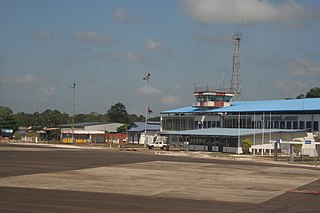
Johan Adolf Pengel International Airport, also known as Paramaribo-Zanderij International Airport, and locally referred to simply as JAP, is an airport located in the town of Zanderij and hub for airline carrier Surinam Airways, 45 kilometres (28 mi) south of Paramaribo. It is the larger of Suriname's two international airports, the other being Zorg en Hoop with scheduled flights to Guyana, and is operated by Airport Management, Ltd./ NV Luchthavenbeheer.

Jodensavanne was a Jewish plantation community in Suriname, South America, and was for a time the centre of Jewish life in the colony. It was established in the 1600s by Sephardi Jews and became more developed and wealthy after a group of Jews fleeing persecution in Brazil settled there in the 1660s. It was located in what is now Para District, about 50 km (31 mi) south of the capital Paramaribo, on the Suriname River. Sugarcane plantations were established and Black African people were used as slave labour. At its height in around 1700 it was home to roughly 500 plantation owners and 9000 slaves. The colony faced regular attacks from Indigenous people, slave revolts, and even raids from the French navy. The community eventually relocated to the capital of Paramaribo. Clearing of grave sites and maintenance of the synagogue ruins has been attempted at various times from the 1940s to the 21st century.

Michaël Henricus Gertrudis (Michiel) van Kempen is a Dutch writer, art historian and literary critic. He has written novels, short stories, essays, travel literature and scenarios. He was the compiler of a huge range of anthologies of Dutch-Caribbean literature and wrote an extensive history of the literature of Suriname, in two volumes.

Juwana Morto is former coastal artillery battery on the island of Aruba. It was used to defend Aruba during World War II. It is located toward the south end of the island, within the district of San Nicolaas. Most of the building has been demolished, and only the foundation remains.
Prostitution in Suriname is illegal but widespread and the laws are rarely enforced. Human trafficking and Child prostitution are problems in the country. Prostitutes are known locally as "motyo". UNAIDS estimate there to be 2,228 prostitutes in the country.

The Kingdom of the Netherlands, commonly known as simply the Netherlands, is a sovereign state and constitutional monarchy with 98% of its territory and population in Western Europe and with several small West Indian island territories in the Caribbean.

Beekhuizen is a former sugarcane plantation and currently a resort in Suriname, located in the Paramaribo District. Its population at the 2012 census was 17,185.

The Colony of Curaçao and Dependencies was a Dutch colony from 1815 until 1828 and from 1845 until 1936. Between 1936 and 1948, the area was officially known as the Territory of Curaçao, and after 1948 as the Netherlands Antilles. With the proclamation of the Charter for the Kingdom of the Netherlands on 15 December 1954, the Netherlands Antilles attained equal status with the Netherlands proper and Suriname in the overarching Kingdom of the Netherlands.
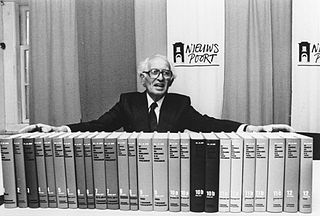
The Kingdom of the Netherlands During World War II is the standard reference on the history of the Netherlands during World War II. The series was written by Loe de Jong (1914–2005), director of the Dutch Institute for War Documentation, and was published between 1969 and 1991. The series contains 14 volumes, published in 29 parts. De Jong was commissioned to write the work in 1955 by the Ministry of Education, Culture and Science. The first volume appeared in 1969, and de Jong wrote his last in 1988. The final volume, containing critique and responses, appeared in 1991.

Marinekazerne Suffisant is a Dutch armed forces base located on Curaçao. Until 2009, it was used by the infantry company 31 INFCIE of the Netherlands Marine Corps. Currently the base is used for the conscription of Curaçaoan youths. However, rather than being purely military in nature, the conscription also serves a social purpose: conscripts can get an education and receive diplomas on the base. During the first six months the conscripts receive military training and in the remaining six months they study to obtain a diploma. The conscripts are called miliciens. Currently the Royal Marechaussee has a brigade stationed on the base as well.

The Free Dutch Forces refers to the Dutch military formations of the Dutch government-in-exile and its colonies that were formed to fight alongside the Western Allies against Nazi Germany and its allies during World War II following the Dutch surrender in May 1940.

During the First World War between 1914 and 1918, approximately one million Belgians fled across the border to the Netherlands. These refugees were both civilians who were afraid of the war and the alleged atrocities of the Germans, and soldiers who either deserted or were cut off from their army unit.
Hugo Desiré Rijhiner was a Surinamese officer in the Royal Netherlands East Indies Army who was awarded the Military William Order for his actions in the Battle of Rotterdam. Together with Harry Voss, Rijhiner remains one of only two Surinamese soldiers to have been awarded the Military William Order.
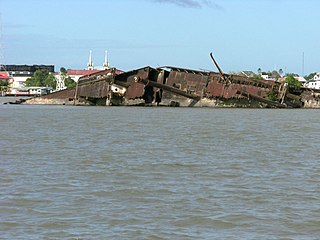
Goslar is a German turbine steamboat, and was in service as a freighter. She was built in 1929 in Hamburg. On 5 September 1939, she surrendered in Suriname. On 10 May 1940, Germany invaded the Netherlands, and the ship was scuttled by her crew. Attempts to remove the wreck in 1955 failed, and has resulted in the ship breaking in two parts.

Katwijk is coffee plantation and village in the Alkmaar resort of the Commewijne District of Suriname. It is the only coffee plantation in Suriname which is still in operation. During World War II, Katwijk was an internment camp for prostitutes.
Wim Bos Verschuur, born Bernard Willem Hendrik Verschuur was a Surinamese politician, activist, artist, and writer. On 30 July 1943, he was arrested and interned for opposing governor Johannes Kielstra; this caused a major scandal in Surinam politics and led to a larger wave of repression against opposition figures.
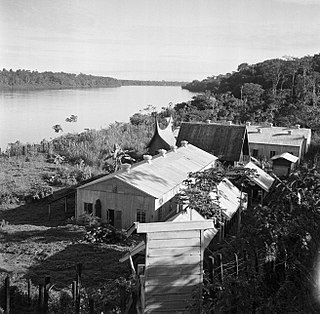
Jodensavanne was a Dutch Internment Camp for Political prisoners from the Dutch East Indies operated in Surinam during World War II. The camp was named after a nearby, long-abandoned Jewish colony, Jodensavanne.
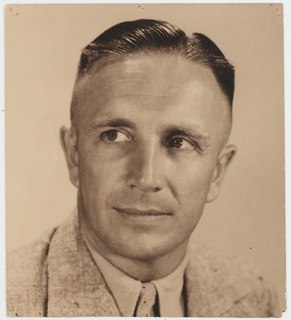
Louis Johan Alexander Schoonheyt (1903-1986), commonly known as L. J. A. Schoonheyt, was a Dutch medical doctor, writer, and supporter of the National Socialist Movement in the Netherlands before World War II. From 1935 to 1936 he was the camp doctor at the Boven-Digoel concentration camp in New Guinea, Dutch East Indies, and is mostly known today for the book he wrote about his experiences there, Boven-Digoel: Het land van communisten en kannibalen (1936). His praise for the conditions in the camp earned him the ire of the internees, Indonesian nationalists, and Dutch human rights advocates; E. du Perron called him a 'colonial bandit', while many internees burned his book after reading it in the camp.
















